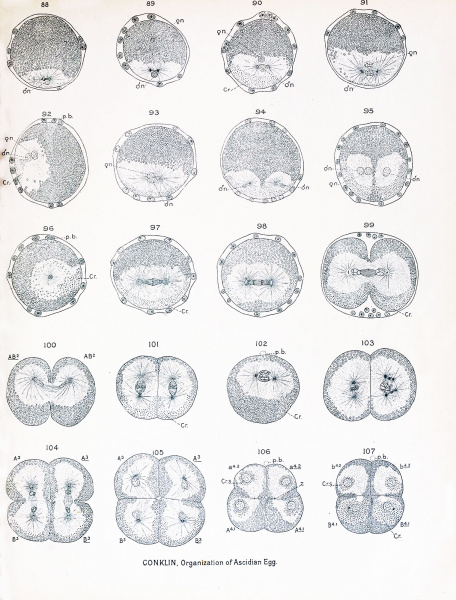File:Conklin 1905 plate07.jpg

Original file (1,521 × 2,000 pixels, file size: 775 KB, MIME type: image/jpeg)
Plate VII Sections of Eggs of Cynthia partita - Fertilization and Early Cleavages
Fig. 88. Division of sperm aster ; crescent substance at periphery on posterior side.
Fig. 89. Similar to preceding but showing egg nucleus.
Figs. 90 and 91. Sections at right angles to first cleavage plane but oblique to egg axis, showing the union of pronuclei; clear and yellow protoplasm and sperm amphiaster in posterior half of egg.
Fig. 92. Section in the plane of the first cleavage (future median plane) showing the union of the germ nuclei, the clear protoplasm and crescent on the posterior side of the egg, and the polar bodies above.
Fig. 93. Early prophase of the first cleavage, in the plane of the spindle axis.
Fig. 94 and 95. Two dispermic eggs; the first showing two sperm nuclei on the posterior side of the egg with a single crescent ; the second, two sperm nuclei and one egg nucleus, with the clear protoplasm and crescent about equally divided, by a tongue of yolk, between the two sperm nuclei.
Fig. 96. Section in the plane of the first cleavage and transverse to the spindle, showing a cross section of the equatorial plate near the middle of the egg, surrounded by clear protoplasm, also the crescent at the posterior border with some of the yellow spherules all around the spindle.
Fig. 97. Metaphase of the first cleavage; equatorial section at right angles to the preceding.
Figs. 98 and 99. Early and late anaphases of the first cleavage; sections in equatorial plane.
Fig. 99. Constriction of cell body; chromosomal vesicles at the ends of the nuclear spindle. In both figures the daughter centrosi is are elongating in the equatorial plane and at right angles to the first spindle axis.
Fig. 100. Telophase of the first cleavage, showing the rotation of nuclei, eentrosomes and cytoplasm toward the animal pole of the egg.
Fig. 101. Equatorial section, prophase of second cleavage; crescent substance at the posterior pole.
Fig. 102. Section at right angles to the preceding and through the axis of one of the spindles; nucleus and cytoplasm lie above the equator, yolk and crescent below.
Fig. 103. Equatorial section showing precocious division of the eentrosomes in one of the blastomeres.
Fig. 104. Anaphase of second cleavage; equatorial section ; chromosomal vesicles at ends of nuclear spindles.
Fig. 105. Telophase of second cleavage ; equatorial section, showing the bending of the middle of the spindle toward the center of the egg, and a large amount of clear cytoplasm aud of crescent substance in the posterior quadrants.
Figs. 106 and 107. Two sections through one and the same egg in the eight-cell stage ; the first through the anterior blastomeres ; the second through the posterior. The cytoplasm is most abundant in the cells at the animal pole, the crescent substance in the two posteriorvegetal cells, though it is also found around all the nuclei. The polar bodies, which are shown in stippled outlines, are not in the plane of either of these sections, but in the region between them.
| Historic Disclaimer - information about historic embryology pages |
|---|
| Pages where the terms "Historic" (textbooks, papers, people, recommendations) appear on this site, and sections within pages where this disclaimer appears, indicate that the content and scientific understanding are specific to the time of publication. This means that while some scientific descriptions are still accurate, the terminology and interpretation of the developmental mechanisms reflect the understanding at the time of original publication and those of the preceding periods, these terms, interpretations and recommendations may not reflect our current scientific understanding. (More? Embryology History | Historic Embryology Papers) |
- Conklin Figures: Fig 1-2 | Fig 3-6 | Fig 7-8 | Fig 9-12 | Fig 13-16 | Fig 17-20 | Fig 21-24 | Fig 25-26 | Fig 27-33 | Fig 34-35 | Plate I | Plate II | Plate III | Plate IV | Plate V | Plate VI | Plate VII | Plate VIII | Plate IX | Plate X | Plate XI | Plate XII
Reference
Conklin EG. The Organization and Cell-Lineage of the Ascidian Egg (1905) J. Acad., Nat. Sci. Phila. 13, 1.
Conklin 1905 TOC: I. The Ovarian Egg | II. Maturation and Fertilization | III. Orientation of Egg and Embryo | IV. Cell-Lineage | V. Later Development | VI. Comparisons with A.mphioxus and Amphibia | VII. The Organization of the Egg | Summary | Literature Cited | Explanation of Figures
Cite this page: Hill, M.A. (2024, April 23) Embryology Conklin 1905 plate07.jpg. Retrieved from https://embryology.med.unsw.edu.au/embryology/index.php/File:Conklin_1905_plate07.jpg
- © Dr Mark Hill 2024, UNSW Embryology ISBN: 978 0 7334 2609 4 - UNSW CRICOS Provider Code No. 00098G
File history
Click on a date/time to view the file as it appeared at that time.
| Date/Time | Thumbnail | Dimensions | User | Comment | |
|---|---|---|---|---|---|
| current | 16:10, 19 October 2016 |  | 1,521 × 2,000 (775 KB) | Z8600021 (talk | contribs) | {{Historic Disclaimer}} {{Conklin1905 figures}} ===Reference=== {{Ref-Conklin1905}} {{Conklin1905 TOC}} {{Footer}} |
You cannot overwrite this file.
File usage
The following 2 pages use this file:
